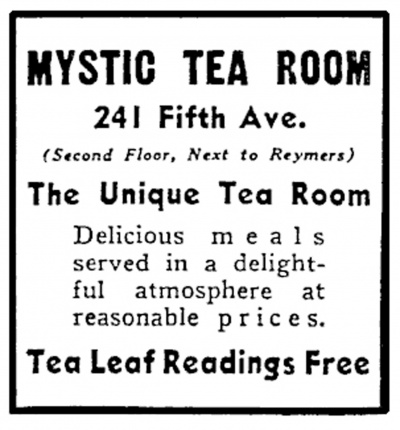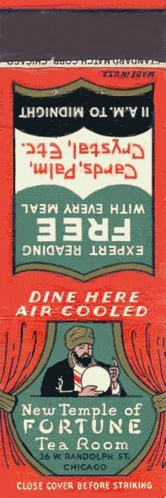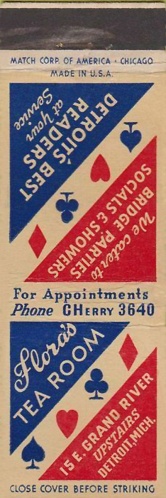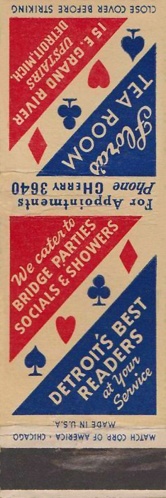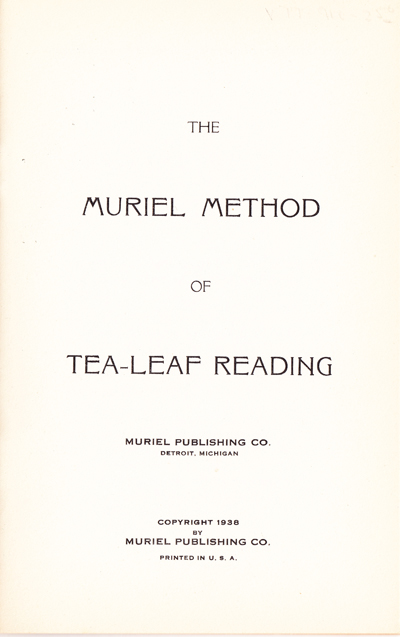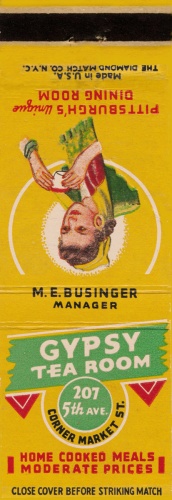Having Your Fortune Told At a Tea Room
From Mystic Tea Room
In this installment of "From the Land of Tea," we take a look at a web page that was funded by my Patreon supporters, who had access to it one full year before the public.
- Patreon Release Date: July 21st, 2021
- Public Release Date: July 21st, 2022.
Please consider subscribing to my Patreon stream for as little as $2.00 per week:
Patrons: To discuss this and other Patreon pprojects with me, please join my private Patreon Forum:
Support From the Land of Tea
All of the material you have access to here -- the fabulous tea cups, the instructive booklets, the nostalgic postcards, the boldly graphic matchbook covers, and all of the historical information researched and shared from the mind of the woman who is making it all happen -- can easily fit into one 8 x 10 foot room in an old Victorian farmhouse, but you would never see it without the investment of the time it takes to produce such a site and the caloric input such a site requires in the form of food for the writer, graphic designer, and database manager, as well as the US currency needed to pay for the computers, software applications, scanners, electricity, and internet connectivity that bring it out of that little room and into the world. So, as you can see, this site is the darling of many, and it is growing at a rapid rate ... but although it is "free," there also is a cost. Your financial support underwrites this cost.
Each new web page or sample pdf is circulated to Patrons as an unpublished galley proof or advance copy. After one year access for Patrons, each web page will be released to the public, while book pages will be available to the public as printed books, and copies will be sent to Patrons who subscribe at the upper two tiers.
Patrons have access to a Private Patreon sub-forum within the Lucky Mojo Forum, and will be accorded special Red Star Avatar badges at the Forum.
Having Your Fortune Told At a Tea Room
In the past, and at a few places at the present time, a sitter could get free tea leaf readings from the waitresses at a "Gypsy" themed tea room, cafe, or restaurant. The best known of these places was, of course, The Mystic Tea Room, Bernice Barton's Pittsburgh restaurant after which this site was named. Other well-known tea leaf reading eateries were The Gypsy Tea Kettle, The Gypsy Tea Shop, The Gypsy Tea Room, The New Temple of Fortune Tea Room, The Egyptian Tea Room, The Spanish Court Tea Room, the Wishing Cup Tea Room, and The Original Tremont Tea Room.
But how did these Tea Leaf Reading Tea Rooms come about -- and where have they gone?
Restaurants and the Female Suffrage Moment
The story of tea leaf fortune telling in tea rooms and tea shops begins with the connection between tea rooms and the female suffrage movement. As restaurant dining became more common in the mid to late 19th century, growing right beside it were the intertwined women’s movements that led to the establishment of public education, divorce laws that permitted women to escape abusive marriages, inheritance laws that allowed women to own and manage businesses, and the long, hard fight for female suffrage.
Tea room ownership was an important social factor in the liberation of women, and quite often, on business cards and in newspaper advertisements, the names of female proprietors were proudly listed. The unspoken message these female ownership names conveyed to women who saw the advertisements was that by dining at a woman-owned tea room you were effectively supporting a broad range of progressive political and social programs.
(Read More about Tea Room History)
Themed Tea Rooms
Tea Rooms were among the first "theme" restaurants.
These primarily woman-run establishments proliferated beyond the borders of the United States, too. There were rural tea rooms everywhere, from Canada to New Zealand, as well as in the British Isles. Wherever women sought independent incomes by catering to women motorists, tea rooms sprang up to meet the need.
Among the themes used by tea rooms of the 20th and 21st centuries are:
- Potted Plants, Palm Courts, and Indoor Gardening
- Outdoor Dining and Gardening
- Tea Room Gift Shops, Crafts Shops, and Antiques Stores
- Ancient and Repurposed Buildings as Tea Rooms
- Rustic and Rural Roadside Tourist Tea Rooms
- Educational and Charitable Tea Rooms
- American Colonial Tea Rooms
- Victorian and Edwardian Tea Rooms
- Art Deco and Streamline Moderne Tea Rooms
- Asian Tea Gardens and Tea Rooms
- Counter-Cultural ("Bohemian) themed Tea Rooms
- Romani ("Gypsy") themed Tea Rooms
- Psychic Fortune Telling Tea Rooms
It is the last three in this list — the Bohemian and Romani themed tea rooms and the fortune telling tea rooms — that interest me here.
"Gypsy" and "Bohemian" as Tea Room Themes
Before i begin, i think it is important to discuss the words "Gypsy" and "Bohemian" as they were used from the 19th and 20th centuries to the present.
"Gypsy"
Gypsy is an English word that at one time was applied to the Romani people in the false belief that they were indigenous Egyptians. (They actually trace their roots to India.) They were not permitted to settle or own land, and so they took up a nomadic way of life. The Roma spread into North-Western Europe and Great Britain from Eastern Europe and it was from their sojourn in Romania that they got the name Romani.
By the 19th century, the word "Gypsy" had been applied to non-Roma vagabonds, particularly those who lived in caravans or vans in the fashion of the Roma, and who found work at a trade while on the road. Trades prominent among Romani and other vagabonds, such as the Irish Travellers, included tin-smithing, knife-sharpening, portrait photography, musical performances, horse-trading, fortune telling by palmistry, and selling herbal medicines. The word "Gypsy" was also applied to non-Roma musicians who wore Austro-Hungarian costumes and performed in cafes and restaurants.

During the occult and hermetic revival of the late 19th century, several misguided authors declared that tarot playing cards, which had originated in Italy, were "Egyptian" in origin, and this led to a variety of makers creating "Gypsy" oracle card decks for divination. The German word for Romani people is Zigeuner," and Zigeuner Wahrsage Karten -- Gypsy Fortune Telling Cards -- were published in Vienna with text in six European languages. The Romani, who had a long cultural history of palm reading, took up cartomancy and became proficient at it.
In America "Gypsy" became a common term for any psychic reader, regardless of whether the reader was Romani, Jewish, White, or Black -- or whether the reader travelled from town to town, practiced palmistry, or used playing cards, oracle cards, or tarot cards to divine the future. Thus an African-American psychic reader who foretold the future with a crystal ball might be called a "Black Gypsy," and a Jewish musician who played violin in a cafe, might be called a "Gypsy Violinist."
I want to strongly affirm that i refer to Roma people as Romani, but because "Gypsy" -- a completely made-up word derived from the spuriously-applied adjective "Egyptian" -- was the proper name given to many tea rooms, is the brand-name of quite a few fortune telling tea cups and cartomancy decks, appears in dozens of old African American blues lyrics about psychic readers], and was taken by numerous psychic readers as a self-descriptor, i will continue to use that word as specified in earlier decades.
Bohemian
The word "Bohemian" has a similar rough and rugged history. It originally was used to identify people who lived in Bohemia, a region once part of the Austro-Hungarian Empire, but now set out as the westernmost region of the Czech Republic. Within that area lived many Romani people, as well as Jews and indigenous Europeans, some of whom spoke Czech, and some of whom spoke German or Yiddish.
As immigrants to America from Bohemia, these people could all legitimately be called "Bohemian." However, the word Bohemian became blurred with the word "Gypsy" when it referred to Romani Bohemians, and from there it spread out to encompass people of any ethnicity who chose not to live conventional life-styles, who might move from place to place, or who followed any of the "Gypsy" trades mentioned above. It also referred to women who wore headscarves (Jewish and Romani married women cover their hair) and to men who played Middle-Eastern music in a minor key on a violin, many of whom were actually Jewish, but dressed as Hungarian "Gypsies" (Romani people) in order to find work in antisemitic venues.
In the United States, "Bohemian" was a term that meant "counter-cultural," but it was also the brand name of a very popular Czech-style beer brewed in Detroit, the name for a club of White men who met yearly in Northern California for rites of libertinage, for White women who refused to wear corsets, for cigarette-smoking Jewish lesbians, for artists and poets of all ethnicities, and for Jewish fiddlers, many of whom actually had come to America from Austria, Poland, Ukraine, Lithuania, Hungary, or Germany rather than Bohemia.
In these pages i use the words "Czech," "Hungarian," "Austrian," and the like to refer to the regions of origin of various people, and i use the term "Bohemian" both as a place-name descriptor and as it has long been applied, to refer to counter-cultural, liberal, far-left-wing Americans who earn their livings by artistic or spiritual creativity.
Tea Leaf Reading as a Tea Room Theme
In urban America, where immigrants struggled to earn a living, the Eastern European themed tea room movement took hold. At the Gift Shop Tea Room in New York you could buy the antique dinnerware on which you were served, and much of it was copperware from Poland and Russia. There was a Russian Tea Room and a Russian Bear Tea Room. The Romani theme of Hungary and Romania gave rise to a Gypsy Tea Shop, a Gypsy Tea Room, and several Gypsy Tea Kettle Tea Rooms. When times got hard during the Great Depression of the 1930s, the owners of these small tea rooms took to luring in female diners by reading tea leaves, and offering palmistry, numerology, and crystal ball scrying — “Free With Every Meal!”
Exotically-themed tea rooms that offered fortune telling or psychic reading services were often called "Gypsy" tea rooms. One psychic reading tea room in Kansas City was called the Egyptian Tea Room, and there were others, such as the New Temple of Fortune and the Spanish Court Tea Room which offered a variety of divination services in addition to tasseomancy.
Psychic tea room parlours could be found in most major cities, from New York to Los Angeles. Quite a few were located on the second or third floor of a downtown building, which reduced casual foot traffic and also lowered rental costs. Because they did not feature picturesque exteriors, they rarely were documented with postcards except as incidental signage in a Main Street view card, but they did offer advertising via business cards and matchbook covers
The Free Reading During Hard Times
When the Great Depression laid the United States economy low in 1929, restaurants and theaters, always a luxury, fell on economic difficulties. To lure folks in, they devised a variety of giveaways. Movie houses held "dish night" promotions in which a carnival wheel was spun on stage and lucky ticket holders received free kitchenware. Tea rooms in the countryside added gift shops and antique stores to bolster income, while tea rooms in the cities began offering free tea leaf readings. These psychic fortune telling tea rooms used slogans like "It's All In the Leaves," "Your Fortune Free in Leaves of Tea," and "Free Reading With Every Meal" on their business cards, matchbook covers, and newspaper advertisements.
The readings offered in these second- and third-floor psychic-themed tea rooms were indeed free, as advertised, but the waitress who read your leaves or the psychic ensconced in a corner at a private table could expect a small tip for his or her services. Some psychic readers were so hard-hit by the economic downturn of the Depression that they worked their corner table for nothing more than tips and the day's free meals, which they received from the tea room proprietor. Even fine hotels and fancy theaters added tea cup readers to the list of attractions they offered to bring in customers during hard times.
In May, 1934, according to s series of newspaper ads in the Calgary Herald, Professor Usher offered cup divination at the York Hotel Coffee Shop at 7th Avenue and Centre Street, Calgary, Alberta, Canada (Telephone M4748). The "Great Exponent of Psychic Powers as Used in India" seems to have combines tea leaf reading with sand geomancy, for the ad copy of May 19th, 1934 explains that he offers, "Cup divinations -- not ordinary cup reading -- but the centuries-old method used by the seers of India in their divination with sand -- used by Yogis (the holy teachers) -- as the means whereby they peer through and beyond the wavering curtains of uncertainty before the door of tomorrow -- a method which has been lauded for years by Eastern travelers for its remarkable forecasts." In another Calgary Herald ad, from May 26th, we learn that Professor Usher was held over one more week at the York Coffee Shop "by Popular Demand."
Going back two years, to 1932, we learn that this reader's name is George Usher, for an ad in the Calgary Herald for March 18, 1932 tells us that at the Capitol Theatre, where the first run film was "Shanghai Express" directed by Josef von Sternberg, with Marlene Dietrich, Clive Brook, Anna May Wong, Warner Oland, and Eugene Pallette, there was on offer in the Mezzanine Lounge for "Ladies Teacup Reading" by "George Usher (Late of the Hotel York Coffee Shop)." This means that Usher's "re-engagement" in 1934 referred back to his time at the Hotel York coffee Shop going back prior to March, 1932 -- and prior to assuming the performance title of "Professor."
The Law Cracks Down
American attitudes toward fortune telling have always been mixed. About ten to twelve percent of all Americans seek out a psychic reader during the course of any given year. However, reports of fraudulent readers and fake psychics always make the news, and as a result, there are local crackdowns from time to time and from place to place, especially when it seems that fortune telling has become popular enough to attract professional con artists to the trade. To keep fortune telling respectable, in some counties, fortune tellers have to post a bond; in other areas they have to pay undercover bribes to local law enforcement agents.
It is quite common for a town or county to pass a local law that, while not completely outlawing fortune telling because it is protected speech under the First Amendment of the United States Constitution, still requires that it be voiced "for entertainment purposes only. " Such laws, and the similar ones that require magical herbs and roots to be sold "as a curio only," are frequently challenged and overthrown, and there are far fewer of them on the books in the 21st century than there were in the 20th century, but they have existed, and they have left their marks.
Take for instance this newspaper article from the Ludington, Michigan, Daily News of September 24, 1930, which was brought to my attention by Dixie M. Ford. In it, we learn of arrests being made in Detroit, Michigan, where psychic tea leaf reading had suddenly appeared -- and just as suddenly become a crime.
Two women were arrested for reading tea leaves in a restaurant. There were Mrs. Erma Libson, age 48 (born circa 1882) and Miss Margaret King, age 31 (born circa 1899). The anonymous Associated Press reporter who wrote the article noted that tea leaf reading in restaurants had become "a fad with many persons here for some weeks," that is, since the summer of 1930. The case was adjourned by the judge for two weeks and the outcome seems to have gone unreported, but i know with certainty that tea leaf reading in restaurants in Detroit did not come to an and that day!
How do i know that tea leaf reading in Detroit survived the big bust of 1930? Because, for one thing, here is a matchbook for Flora's Tea Room at 15 East Grand River in Detroit, advertising by means of card suits as cartomancy symbols, plus the words "Detroit's Best Readers at Your Service" on the outside. On the inside of the Flora's Tea Room matchcover we see that the psychic readers are listed as "entertainers" -- which may have been the work-around that was employed to avoid more arrests at tea rooms in Detroit. The readers are all female, and their performance names and ethnicities are given, but not the forms of readings they provide. We know from the front of the matchbook cover that at least one of the readers used playing cards, and the fact that their services are offered in a tea room means that tea leaf readings were offered as well -- either for free, as at the Egyptian Tea Room in Kansas City, where the free tea leaf reading was a come-on for the paid crystal ball reading, or as an alternative to the tea reading, and included in the price of the meal. At Flora's Tea Room the three readers and their ethnic presentations were Benita ("Spanish"), Jeanette ("Indian" — which, accompanying the name "Jeanette," was probably intended to represent Native American, not South Asian), and Phelmene (Belgian -- a strange choice for "exoticism," to say the least, and possibly connected to the reader's true ethnicity).
Second, i have in my collection a delightful little booklet called "The Muriel Method of Tea-Leaf Reading," published in Detroit in 1938, in which the author, Muriel, tells all about how to read tea leaves in a restaurant, just as she does. There is no way to prove it, but if Muriel did not read at Flora's Tea Room, she probably read at another downtown Detroit tea room much like it, called the Bohemian Cave Tea Room at 1234 Library Avenue. All we know about the mysterious Muriel is that she wrote the only contemporary instructional text that teaches the tea reader how to perform as a psychic in a tea room, including where to locate yourself in the tea room space and how to present the reading to the sitter. For more about this booklet, including a view of its cover, see the Bibliography of Books about Tasseomancy.
The Bohemian Cave tea room in Detroit presents an interesting case of code-switching, that is, deliberately using the same words to say different things to different audiences. The newspaper advertisement shown above ran in the "Detroit Jewish Chronicle" on September 21st and 28th, 1928. Published in a Jewish newspaper, the word "Bohemian" refers to Bohemia, also known as Czechoslovakia or Czechia, and especially to the Jewish center of learning in Prague, indicating that Jews were welcome to dine there. However, to a non-Jewish Detroiter in search of a tea cup reading, the word "Bohemian" would seem to refer to the locally-brewed brand of alcohol, Stroh's Bohemian Beer, or the Romani people known as "Bohemian Gypsies," indicating that fortune-telling, palmistry, crystal gazing, and card reading would be conducted on the premises.
There is another odd piece of code-switching in this ad: "Look for Big Barrel in the Window." The big barrel was a wooden beer barrel, Bohemia was the land where the hops came from to make good beer, and a Bohemian Cave would be where the Stroh's Bohemian Beer barrels were stored -- but 1928 was during Prohibition, so the barrel, once the symbol of a Bohemian tavern, was now a faultless tea room, strictly on the up-and-up ... except for the big barrel in the window, the demi-legal psychic readers, and all that weird Jewishness. Was there a speakeasy in the basement? I have a feeling the cops hated this place.
The Leatherneck Tea leaf Reader
Now let's take a deeper dive into another themed tea room where free readings were offered: The Gypsy Tea Room, also known as the Gypsy Tea Shop, at 207 Fifth Avenue, Pittsburgh, Pennsylvania, under the management of M. E. Businger.
So ... who was M.E. Businger, and what else was going on at the Tea Room? Thanks to newspaper digitization resources, we have some answers. I have transcribed these short articles from OCR records:
The Pittsburgh Press, Pittsburgh, Pennsylvania; Sunday, October 17, 1943; page 52
MARINE GROUP ENDORSES PROTHONOTARY FRASHER
In a resolution made public yesterday, the Leathernecks, an organization of Marine Corps veterans, announced the endorsement of Prothonotary William H. Frasher, Republican candidate for re-election. The resolution, signed by M. E. Businger and others, said Mr. Frasher has had 16 years' experience in the office while his opponent. David B. Roberts, Democrat. lacked the experience necessary for the office.
The Pittsburgh Press, Pittsburgh, Pennsylvania; Sunday, March 10, 1946; page 24
MARINE CORPS LEAGUE
National organization with two Pittsburgh posts. Officers: Commandant, Pittsburgh Detachment, William P. Coyne; Commandant. Leatherneck Detachment, Clem Templeton. Dues: $3 a year. Meetings: Pittsburgh, second and fourth Tuesday each month at 207 Fifth Ave.; Leatherneck, second and fourth Tuesday each month at Fort Pitt Hotel. Who Can Join: Marine veterans of any war and men still in Marine service. Information: Pittsburgh Detachment, call M. E. Businger, 207 Fifth Ave.; Leatherneck Detachment, call Paul Drew, 205 Clark Bldg.
The Pittsburgh Press, Pittsburgh, Pennsylvania; Friday, March 15, 1946; page 6
MARINE CORPS LEAGUE INSTALLS OFFICERS
The Pittsburgh Detachment, Marine Corps League, elected and installed the following new officers at a recent meeting at 207 Fifth Ave.: Commandant, William Coyne; senior vice-commandant, William Silinski; junior vice-commandant, Ed. Campbell; adjutant, Paul Mead; paymaster, M. E. Businger; chief of staff, William Langford; sergeant-at-arms, Don Critchlow, and chaplain, T. Thomas. National Judge Advocate Ralph Thombs, and a team from Youngstown, installed the officers.
Gypsy Tea Shop, Pittsburgh, Pennsylvania, matchbook cover, 1930s; despite the slight name change, from "Tea Room" to "Tea Shop," this is the same establishment as in the previous item;the word "Gypsy" is a slur for the Romani People that was in common use with respect to fortune tellers in the 20th century. |
Gypsy Tea Shop, Pittsburgh, Pennsylvania, matchbook cover, 1930s; despite the slight name change, from "Tea Room" to "Tea Shop," this is the same establishment as in the previous item;the word "Gypsy" is a slur for the Romani People that was in common use with respect to fortune tellers in the 20th century. |
We know that 207 Fifth Avenue was the address of the Gypsy Tea Room / Gypsy Tea Shop -- and that M.E. Businger was the manager, as shown on this matchbook cover. (The building, in what was once a historic district, has been torn down and replaced by wall-of-glass office spaces.)
From the 1943-1946 newspaper articles above we also know that M. E. Businger, the manager of the Gypsy Tea Room / Gypsy Tea Shop, was male, because no women were allowed in the Marine Corps at that time.
The fact that he was issuing political endorsements and hosting meetings for Marine Corps veterans at the tea room during the period of World War Two (1941-1945) and its aftermath (in 1946) would seem to indicate that he had served in the Marines during World War One (1917-1918).
I am pretty confident that he was Maurice Eugene Businger (1897 - 1962) , whose name is found in the "Ohio Roster of Soldiers, Sailors, and Marines in World War I, 1917-1918." He was a man of Swiss and Irish heritage who was born in Cleveland Ohio to Arnold Joseph Businger (1869 - 1952), a circus owner, and Florence A McCurdy Businger (1870 - 1939). Maurice married Lillian Jeanette Loveless Businger (1900-), and they had seven children, some of whom also served in the military. They were eventually succeeded by many grandchildren and great-grandchildren who survive to the present day.
What seems strange to some modern eyes is that a Republican ex-Marine would host a tea room where fortunes were told in tea cups. However, rather than assume that there was a quirky underside to M. E. Businger, i think what what some people may see as Mr. Businger's unexpected "tolerance" for fortune telling is actually evidence of the sharply negative recasting of public opinion against fortune-telling that took place after his death, toward the end of the 20th century.
Throughout the 19th century, domestic divination by means such as playing cards, palmistry, tea leaves, sortilege, and Moon phases, was part of everyday life, as was a general interest in spirituality and occultism. During and after World War One, interest in all of these forms of divination, as well as more technical methods like astrology, numerology, and the I Ching, grew, with many books and monthly magazines devoted to these subjects. As we have seen, some towns and counties cracked down on fortune telling, but in most parts of the country there were no restrictions, if the divination was made "for entertainment purposes only." Even during the 1950s, as secular scientism began to make inroads into the nation's inclinations toward spirituality and religion, fortune telling remained a popular topic. When the hippies came to adulthood in the 1960s and 1970s, interest in the occult hit a new high point.
Then came the evangelical movement, the right-winging of Christianity, and the demonizing of folklore, folk magic, and home-style fortune telling. In 1978 the Christian Right supported the Democratic president, Jimmy Carter, but from 1980 onward, it shifted to supporting Republicans exclusively. However, even as late as 1980-1984, the super-conservative Republican presidential administration of Ronald Reagan was governed according to the principles of astrology. (Don't believe me? Look it up.)
Meanwhile, the nation's demographic balance shifted decisively toward the urban, which meant that rural pleasures, which could not be monetized, gave way to mass-media blitzes of opinion. The rise of cable television, in which the Christian Right played an important role, produced an entire generation that was held in thrall to tales of an imagined divide between the magical and the mundane. This culminated in the Satanic panic of the 1990s, in which innocent people were accused of being sinister occultists. The Christian Right meanwhile went on the offensive against abortion, homosexuality, sex education, euthanasia, contraception, pornography, gambling, and obscenity, while upholding nationalism, creationism, Sunday blue laws, prayer in public schools, textbook revisions, and the display of Confederate flags.
With the arrival of the internet, a few old hippies made a deliberate effort to bring occultism and spirituality back from the shadows cast by abstemious and fear-mongering evangelicals, and since the Christian Right was slow to embrace technology, believing that the end-times were too near to bother to learn to code in html, the internet -- first usenet and then the web -- because a playground for magical people and their interests.
When the next generations came on the scene, the first thing they saw was that the net promoted divination, witchcraft, pantheism, hoodoo, and rootwork, while their evangelical parents did not. So, of course they rebelled and took up the banners of mysticism, magic, and supernaturality. But in doing so, many of them failed to listen to the voices from the past. Those old printed books. Those old printed newspapers. Not digitized? Ugh.
And so the young ones appear on my horizon, day after day, month after month, year after year, unbelieving that fortune telling was happily "allowed" back before the internet, that people read tea leaves in restaurants -- that REPUBLICAN EX-MARINES read tea leaves in PITTSBURGH!
Well, the evidence is in. The receipts are here. And M. E. Businger's life stands as an exemplar of how widespread divination and occultism were in the days before the Christian Right tried to demonize it ... and failed.
The Persistence of Tea Leaf Reading in Restaurants

Although from the modern perspective of a teen-aged witch in her comfortable suburban bedroom, it almost seems unbelievable that tea cups were once radical, the truth is that the history of tea leaf reading is also the history of the revolutionaries, the progressives, the rebels, the reformers, the Republican leathernecks and and the courageous suffragettes who led the way to many of the freedoms we now enjoy.
Tea Leaf reading is less common in 21st century restaurants than it was in the 20th century, but the wheels of time continue to spin, and there will always be time to revive tasseography as a hip, new thing.
Perhaps you will be the one to do start the Tea Room Reading Revival.
catherine yronwode
curator, historian, and docent
The Mystic Tea Room
See Also
- Tea Rooms
- Tea Room History
- Having Your Fortune Told At a Tea Room
- Vintage Tea Room Postcards
- Vintage Tea Room Business Cards
- Vintage Tea Room Matchbook Covers
- Dating Tea Room Postcards








